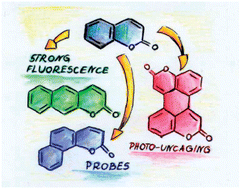π-Expanded coumarins: synthesis, optical properties and applications
Abstract
Coumarins fused with other aromatic units have recently emerged as a hot topic of research. Their synthesis is partly based on classical methodologies such as Pechmann reaction or Knoevenagel condensation, but it also sparked the discovery of completely new pathways. In very recent years so-called vertically expanded coumarins were synthesized, effectively expanding the portfolio of existing architectures. A subtle relationship exists between the structure of fused coumarins and their optical properties. Although absorption of UV-radiation and light is a unifying theme among these π-expanded coumarins, the fluorescence properties strongly depend on the structure. The mode of fusion, the type of additional ring and the presence of electron-donating and electron-withdrawing substituents all influence the photophysical parameters. Recent advances made it possible to modulate their absorption from 300 nm to 550 nm, resulting in new coumarins emitting orange light. This review serves as a guide through both synthesis strategies and structure–property relationship nuances. Strong intramolecular charge-transfer character made it possible to reach suitable values of two-photon absorption cross-section. Photophysical advantages of π-expanded coumarins have been already utilized in fluorescent probes and two-photon excited fluorescence microscopy.


 Please wait while we load your content...
Please wait while we load your content...